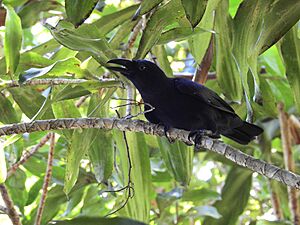Banggai crow facts for kids
Quick facts for kids Banggai crow |
|
|---|---|
 |
|
| C. unicolor in Sulawesi Tengah, Indonesia | |
| Conservation status | |
| Scientific classification | |
| Genus: |
Corvus
|
| Species: |
unicolor
|
| Synonyms | |
|
Corvus enca unicolor |
|
The Banggai crow (Corvus unicolor) is a special bird from the crow family. It lives in the Banggai regency in Central Sulawesi, Indonesia. This crow is listed as critically endangered, which means it's very close to disappearing forever. For a while, people thought it was extinct, but it was found again! An Indonesian bird expert, Mochamad Indrawan, rediscovered it on Peleng Island in 2007 and 2008.
Some people used to think the Banggai crow was just a type of slender-billed crow. However, it's quite different. It looks like an all-black piping crow. The Banggai crow is a small bird, about 39 centimeters (15 inches) long. It is completely black, has a pale eye, and a short tail.
Contents
The Mystery of the Banggai Crow
For over 100 years, scientists only knew about the Banggai crow from two specimens. These were collected from an unknown island in the Banggai Archipelago around 1884 or 1885. People visited the islands in 1991 and 1996, but they didn't find any clear signs of the crow. This made some people think the bird had gone extinct.
Rediscovering a Lost Bird
Luckily, the Banggai crow was not extinct! Between 2007 and 2008, a special study was done on Peleng Island. During this study, the crow was seen many times. An Indonesian ornithologist (a bird scientist) named Mochamad Indrawan even managed to catch and photograph two of these rare birds. This was a very exciting discovery!
Later, in October 2009, a scientist named Pamela C. Rasmussen from the American Museum of Natural History confirmed that the crows found on Peleng Island were indeed the Banggai crow. This proved that the species was still alive.
Where Do Banggai Crows Live?
Scientists believe there are only about 500 adult Banggai crows left in the world. They live in mountain forests at high altitudes, usually above 500 meters (about 1,640 feet).
Why Are They Endangered?
The main reason the Banggai crow population is shrinking is because their home is disappearing. People are cutting down forests for agriculture (farming) and to take out natural resources. This loss of their natural habitat makes it very hard for these special birds to survive.
Protecting the Banggai Crow
The Banggai crow has been a mystery for a long time. It was first listed as "Vulnerable" in 1994, meaning it was at risk. Then, in 2000, its status changed to "Endangered," meaning it faced a very high risk of extinction. In 2006, some even thought it might be extinct. But after its rediscovery, its status was changed to "Critically Endangered" in 2007. This is the highest risk category, meaning it needs urgent help to survive.


